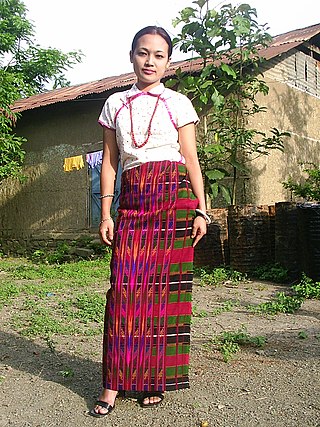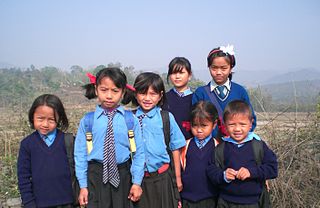
The Insurgency in Northeast India involves multiple separatist militant groups operating in some of India's northeastern states, which are connected to the rest of India by the Siliguri Corridor, a strip of land as narrow as 14.29 miles (23.00 km) wide.

Nagas are various ethnic groups native to northeastern India and northwestern Myanmar. The groups have similar cultures and traditions, and form the majority of population in the Indian state of Nagaland and Naga Self-Administered Zone of Myanmar (Burma); with significant populations in Manipur, Arunachal Pradesh and Assam in India; Sagaing Region and Kachin State in Myanmar.

The Mizo people, historically recorded as the Lushais, are an ethnic group native to the state of Mizoram in India and neighbouring states of Northeast India. They speak the Tibeto-Burman language of Mizo, the official language and lingua franca of Mizoram. The state is the second most literate state in India, at more than a rate of 90%.
The Chin people are an ethnic group native to the Chin State and Rakhine State of Myanmar. Strictly speaking, the term "Chin" only refers to the 53 sub-tribes of the Chin ethnic group, divided and recognized by the Burmese government. They speak the Kuki-Chin-Mizo languages, which are often mutually unintelligible but are closely related.
The Paite people are an ethnic group in Northeast India, mainly living in Manipur and Mizoram. The Paites are recognized as a scheduled tribe in these two states. They are part of the Kuki-Zo people, but prefer to use the Zomi identity. "Guite" is a major clan of the Paite people.

The Kuki people are an ethnic group in the Northeastern Indian states of Manipur, Nagaland, Assam, Meghalaya, Tripura and Mizoram, as well as the neighbouring countries of Bangladesh and Myanmar. The Kukis form one of the largest hill tribe communities in Northeast India, along with the adjoining regions of Bangladesh and Myanmar. In Northeast India, they are present in all states except Arunachal Pradesh. The Chin people of Myanmar and the Mizo people of Mizoram are kindred tribes of the Kukis. Collectively, they are termed the Zo people.

The Zou people Is are an ethnic group, that is an indigenous community living along the frontier of India and Burma, they are a sub-group of the Kuki people/Zo people. In India, they live with and are similar in language and habits to the Thadou people and Paite and the Simte peoples. In Burma, the Zou are counted among the Chin people. They are a hill people, "Zou" may plainly means "Hills" denoting the Zous are "people of the hills" or "of the hills", and "Zou" has also a different meaning in Zou language that is "complete" or another word for it is "finish". But, the Zou people believed that they incepted the name 'Zou' from their forefather 'Zou' or 'Zo', believed to be the progenitor of the broad Chin-Kuki-Mizo people.
Zo is a Northern Kuki-Chin-Mizo language originating in western Burma and spoken also in Mizoram and Manipur in northeastern India.
Guite is the progenitor clan of Zomi people, also called Chin in Myanmar, Mizo, or Paite, or even Kuki in India. According to Zam, Nigui Guite is the elder brother of the ancestral fathers of the Thadou people, namely Thangpi, Sattawng, and Neirawng. This genealogy was recently inscribed on the tribal memorial stone at Bungmual, Lamka in the presence of each family-head of the three major clans, Doungel, Kipgen, and Haokip, on August 7, 2011. Some historians, like Shakespeare, assumed Lamlei was the Nigui Guite himself but the Guites themselves recounted Tuahciang, the father of Lamlei, as the son of Nigui Guite instead, in their social-religious rites. Regarding Guite as the born son of Songthu and his sister, Nemnep, it was the practice of ancient royalty to issue royal heir and also to keep their bloodline pure instead. Depending on local pronunciation, the clan was also called by different names such as Nguite or Vuite, Gwite, Nwite, Paihte by the Lushei. In accord with the claim of their solar origin, the Guite clan has been called nampi, meaning noble or major or even dominant people, of the region in local dialect in the past.
The Lai people mainly inhabit the southern parts of Chin Hills in Myanmar's Chin State, in the townships of Falam, Thantlang and Hakha. They are also found in the Lawngtlai district of Mizoram, India, where they have been granted the Lai Autonomous District Council. Outside this area they are scattered in Mizoram and in Manipur. Their languages "Laizo Lai" and "Hakha Lai" are classified as Central Kuki-Chin languages.
The Sukte are one of the clans of Tedim Chins that mainly inhabit the Tedim district in Myanmar, with small numbers in India, in Manipur, Meghalaya and Assam states. They are recognized as a Scheduled Tribe in Manipur. From 1995, they have been part of the Zomi Re-unification Organisation in Manipur.
The Tedim people, also called Tedim Chins and Tiddim (Hai-Dim) people, are a Zomi ethinic group, part of the Chin people, primarily inhabiting the Tedim Township in the Chin State of Myanmar. They speak the Tedim language, a northern Kuki-Chin language.
The Kuki-Chin-Mizo languages are a branch of the Sino-Tibetan language family spoken in northeastern India, western Myanmar and southeastern Bangladesh. Most notable Kuki-Chin-speaking ethnic groups are referred to collectively as the Zo people which includes: the Mizo of Mizoram, the Kuki of Manipur, Assam, Nagaland, Tripura and Bangladesh and the Chin of Chin State, Myanmar.
The Kuki–Paite Conflict, also called Kuki–Zomi Conflict, was an ethnic conflict during 1997–1998 between tribal communities in Churachandpur district in Manipur, India. The cause of the conflict may be regarded as the desire for leadership within the tribes, pitting one group that subscribed to the Kuki label against another group that subscribed to the Zomi label, the latter being led by the Paites. The conflict started in June 1997 and lasted for over year, during which 352 people died, thousands of homes were destroyed and over 13,000 people were displaced. The Government of India sent in the Indian Army to attempt to stop the violence, but peace was restored in September–October 1998 only with the initiative of the Church.

The Zomi Revolutionary Army (ZRA) is an armed Zomi nationalist militant group formed in 1997, following an increase in ethnic tensions between the Kuki people and the Paites tribe in Churachandpur district of Manipur, India. Its parent organisation, the Zomi Re-unification Organisation, was founded in April 1993.
Ranglong is an ethnic people belonging to the Kuki people. The majority of the Ranglong people live in a small and densely-packed area in the northeastern part of India, mainly in the border areas of Tripura, Assam and Mizoram.
The Kuki Inpi is the traditional form of government of the tribal Kuki people, made up of clan chiefs and village chiefs. After becoming dormant in the early 20th century, it was revived in 1993 in order to safeguard the Kuki people against ethnic conflicts. It currently functions as a social network of the leaders of the community.

Leen Nupa, also spelled Len Nupa, is a valley in Tedim, Chin state, Myanmar. It is also known as Buan Nel.
Northern Kuki-Chin is a branch of Kuki-Chin languages. It is called Northeastern Kuki-Chin by Peterson (2017) to distinguish it from the Northwestern Kuki-Chin languages. VanBik (2009:31) also calls the branch Northern Chin or Zo.

The hill tribes of Northeast India are hill people, mostly classified as Scheduled Tribes (STs), who live in the Northeast India region. This region has the largest proportion of scheduled tribes in the country.









